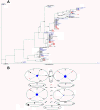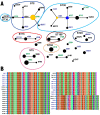Longitudinal genetic analyses of Staphylococcus aureus nasal carriage dynamics in a diverse population
- PMID: 23679038
- PMCID: PMC3673815
- DOI: 10.1186/1471-2334-13-221
Longitudinal genetic analyses of Staphylococcus aureus nasal carriage dynamics in a diverse population
Abstract
Background: Staphylococcus aureus (SA) nasal colonization plays a critical role in the pathogenesis of staphylococcal infections and SA eradication from the nares has proven to be effective in reducing endogenous infections. To understand SA nasal colonization and its relation with consequent disease, assessment of nasal carriage dynamics and genotypic diversity among a diverse population is a necessity.
Results: We have performed extensive longitudinal monitoring of SA nasal carriage isolates in 109 healthy individuals over a period of up to three years. Longitudinal sampling revealed that 24% of the individuals were persistent SA nasal carriers while 32% were intermittent. To assess the genetic relatedness between different SA isolates within our cohort, multi locus sequence typing (MLST) was performed. MLST revealed that not only were strains colonizing intermittent and persistent nasal carriers genetically similar, belonging to the same clonal complexes, but strain changes within the same host were also observed over time for both types of carriers. More highly discriminating genetic analyses using the hypervariable regions of staphylococcal protein A and clumping factor B virulence genes revealed no preferential colonization of specific SA strains in persistent or intermittent carriers. Moreover, we observed that a subset of persistent and intermittent carriers retained clinically relevant community-acquired methicillin-resistant SA (CA-MRSA) strains in their nares over time.
Conclusions: The findings of this study provides added perspective on the nasal carriage dynamics between strains colonizing persistent and intermittent carriers; an area currently in need of assessment given that persistent carriers are at greater risk of autoinfection than intermittent carriers.
Figures





References
-
- Steven AC, Steinert PM. Protein composition of cornified cell envelopes of epidermal keratinocytes. J Cell Sci. 1994;107(Pt 2):693–700. - PubMed
Publication types
MeSH terms
Grants and funding
LinkOut - more resources
Full Text Sources
Other Literature Sources
Medical
Molecular Biology Databases

